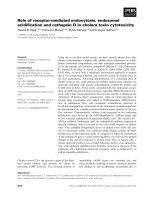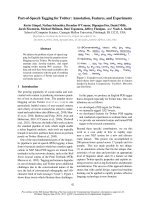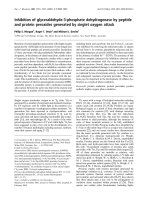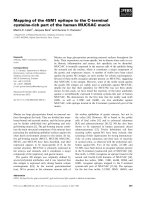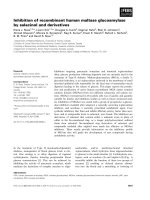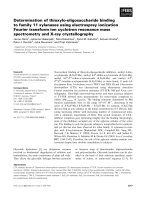Báo cáo khoa học: "Response of Pinus taeda L to soil flooding and salinity SR Pezeshki" ppt
Bạn đang xem bản rút gọn của tài liệu. Xem và tải ngay bản đầy đủ của tài liệu tại đây (647.18 KB, 11 trang )
Original
article
Response
of
Pinus
taeda
L
to
soil
flooding
and
salinity
SR
Pezeshki
Wetland
Biogeochemistry
Institute,
Louisiana
State
University,
Baton
Rouge,
LA,
70803
USA
(Received
21
August
1991;
accepted
6
December
1991)
Summary —
Seedlings
of
Pinus
taeda
L
were
subjected
to
soil
flooding
alone
(F)
and
combined
with
salinity
(FS)
of
50
mol
m
-3
.
The
flooding
effects
on
soil
were
quantified
by
measuring
soil
redox
potential.
Soil
redox
potential
remained
in
the
range
of
+400
to
+450
mV
in
control
pots
while
it
was
reduced
to
-50
to
-140
mV
in
flooded
pots.
Stomatal
conductance
(g)
and
net
carbon
assimilation
(A)
were
reduced
significantly
under
flooding
alone
and
flood/salt
combination
treatments.
Stomatal
conductance
averaged
120
mmol
H2O
m
-2
s
-1
for
control
plants,
while
it
averaged
51
and
45
mmol
H2O
m
-2
s
-1
for
flooded
(F)
and
flooded
plus
salt
(FS)
treatments,
respectively.
Net
carbon
assimila-
tion
was
reduced
from
5.82
μmol
CO
2
m
-2
s
-1
(control
plants)
to
2.22
and
0.09
μmol
CO
2
m
-2
s
-1
in
F
and
FS
plants,
respectively.
The
reductions
in
g
and
A
were
statistically
significant.
Dry
weight
in-
crement
per
plant
was
reduced
from
24.38
g
in
control
to
10.09
and
8.22
g
per
plant
in
F
and
FS
treatments,
respectively.
The
reduction
represents
59%
reduction
in
F
and
66%
reduction
in
FS
treatment.
Based
on
the
present
results,
it
is
concluded
that :
1),
P
taeda
showed
considerable
sen-
sitivity
to
saltwater
treatment
within
the
range
of
soil
anaerobiosis
and
salinity
tested;
and
2),
in
areas
where
saltwater
intrusion
occurs
frequently,
regeneration
and
survival
of
this
species
will
be
adversely
affected.
The
severity
of
such
an
impact
is
partially
dependent
upon
the
intensity
of
soil
re-
duction
and
the
concentration
of
salt
in
floodwater.
flooding
/ forested
wetlands
/ loblolly
pine
/ photosynthesis
/ salt
stress
/ stomatal
conduc-
tance
Résumé —
Réponse
de
Pinus
taeda
L
à
l’inondation
et
à
la
salinité.
L’effet
d’une
inondation
(F)
seule
ou
accompagnée
par
la
salinité
(50
mol/m
3)
sur
le
semis
de
Pinus
taeda
L
a
été
déterminé.
L’effet
de
l’inondation
a
été
évalué
en
mesurant
le
potentiel
d’oxydation
et
de
réduction
(Eh)
du
sol.
Le
potentiel
d’oxydation
et
de
réduction
dans
les
pots
témoins
était
compris
entre
+400
et
+450
mV
alors
qu’il
était
réduit
de
-50
à
-140
mV
dans
les
pots
inondés
(fig
1).
La
conductance
stomatique
(g)
et
l’assimilation
nette
du
carbone
(A)
ont
été
réduites
de
façon
significative
dans
les
pots
soumis
à
l’inondation
(F)
d’une
part
et
l’inondation/salinité
(FS)
d’autre
part.
La
conductance
stomatique
moyenne
était
de
120
mmol
H2O
m
-2
s
-1
dans
les
témoins
et
de
51
et
45
mmol
H2O
m
-2
s
-1
pour
les
pots
seulements
inondés
ou
accompagnés
par
la
salinité,
respectivement.
L’assimilation
du
carbone
était
réduite
de
5,82
mol
CO
2
m
-2
s
-1
dans
les
témoins
à
2,22
et
0,9
mol
CO
2
m
-2
s-1
pour
les
pots
F
et
FS,
respectivement.
La
relation
A-CI
indique
que
l’inondation
seul
ou
accompagnée
par
la
sali-
nité
affecte
la
capacité
de
la
photosynthèse
du
P
taeda
L
par
un
puissant
effet
non
stomatique,
mais
aussi
de
façon
significative
par
la
régulation
stomatique
(fig
4).
L’augmentation
du
poids
sec
par
plant
a
été
significativement
réduite
de
24,38
g
dans
les
témoins
à
10,9
et
8,22
g
dans
les
F
et
FS,
respectivement
(tableau
II).
Ces
réductions
représentent
59%
et
66%
pour
les
F
et
FS.
Ces
résultats
suggèrent
que :
-
le
P
taeda
L
montre
une
sensibilité
considérable
à
l’eau
salée
dans
les
intervalles
testés;
-
la
régénération
et
la
survie
de
cette
espèce
sont
sérieusement
affectées
dans
les
endroits
où
l’intru-
sion
de
l’eau
salée
est
assez
fréquente.
La
sévérité
de
cet
impact
dépend
partiellement
de
la
diminu-
tion
du
potentiel
de
réduction
du
sol
et
du
degré
de
salinité
de
l’eau.
inondation
/
photosynthèse
/
forêt
inondée
/
salinité
INTRODUCTION
Pinus
taeda
L
is
a
mesophytic,
moderately
flood-tolerant
species
(Hook,
1984).
This
species
grows
on
a
wide
range
of
soils
in-
cluding
flat,
poorly
drained
areas
of
the
lower
coastal
plain
in
pure
as
well
as
mixed
stands
(USDA,
Forest
Service
1965).
On
wet
site
sites
it
is
associated
with
Liquidambar
styraciflua,
Nyssa
sylvat-
ica,
Quercus
nigra
and
Fraxinus
pennsyl-
vanica.
On
drier
sites,
it
is
found
with
Q
fal-
cata
var
falcata,
Q
alba
as
well
as
with
P
echinata
and
P
palustris.
Portions
of
these
forests
in
areas
adjacent
to
the
coast
ex-
perience
flooding
and,
in
some
cases,
pe-
riodic
saltwater
intrusion
as
a
result
of
sub-
sidence
and/or
high
tidal
events
caused
by
tropical
storms.
The
adverse
effects
of
flooding
on
survi-
val
and
growth
of
P
taeda
seedlings
has
been
documented
in
several
reports
(Hunt,
1951;
Topa
and
McLeod,
1986).
Flooding
for
3
months
with
stagnant
water
reduced
growth
of
P
taeda
(Hunt,
1951).
Significant
reduction
in
biomass
of
P
taeda
after
2
months
of
exposure
to
soil
flooding
was
found
by
Topa
and
McLeod
(1986).
Per-
manent
root
injury
has
been
reported
when
P
taeda
seedlings
were
flooded
for
10
months
(Hunt,
1951).
Flood-induced
conditions
substantially
reduced
root
bio-
mass
of
several
southern
US
pine
species
(Hook
et al,
1983;
McKee
et al,
1984).
Along
the
US
Gulf
Coast,
high
tidal
events
caused
by
tropical
storms
have
previously
been
associated
with
mortality
of
various
salt-sensitive
species
including
P
taeda
(Little
et
al,
1958;
Land,
1974).
While
the
growth
response
of
P
taeda
to
various durations
of
flooding
(but
not
inten-
sity
as
determined
by
soil
redox
potential,
Eh)
has
been
documented,
little
is
known
about
the
threshold
levels of
soil
hypoxia
and
sublethal
salinity
which
triggers
vari-
ous
responses
of
this
species.
Several
important
areas
of
research
which
needed
to
be
addressed
included
quantifying
such
terms
as
"flooding".
As
pointed
out
by
DeLaune
et
al
(1990),
to
evaluate
the
threshold
levels
of
physiologi-
cal
responses
of
plants
to
soil
flooding,
it
is
important
to
quantify
oxygen
demand
in
the
root
environment.
Additionally,
com-
mon
responses
of
trees
to
root
hypoxia
in-
clude
stomatal
closure
(Kozlowski,
1982,
1984;
Tang
and
Kozlowski,
1982)
and
re-
duction
in
net
photosynthesis
even
in
high-
ly
flood-tolerant
species
such
as
Taxodium
distichum
(Pezeshki
et
al,
1986,
1987).
However,
little
information
is
available
on
the
physiological
responses
of
P
taeda
to
increases
in
salinity
levels
in
the
presence
of
flooding.
Assessment
of
physiological
response
of
P
taeda
seedlings
to
salt
stress
is
of
great
importance
in
order
to
identify
the
possible
adaptation
and
(or)
acclimation
to
saline
conditions.
Mainte-
nance
of
positive
net
photosynthesis
is
an
important
factor
contributing
to
the
survival
and
growth
of
a
given
species
under
nonle-
thal
salinity
conditions.
Reports
of
stomatal
and
photosynthetic
behavior
of
P
taeda
to
individual
and
combined
flooding
and
salin-
ity
stresses
is
limited.
The
present
study
was
conducted
to
investigate
the
effect
of
floodwater
salinity
on
gas
exchange
in
P
taeda.
The
effects
of
individual
and
com-
bined
hypoxia
and
salinity
on
net
carbon
assimilation
of
this
species
and
the
subse-
quent
effects
of
these
stresses
on
growth
and
biomass
partitioning
was
evaluated.
MATERIALS
AND
METHODS
Pinus
taeda
L
seedlings
obtained
from
the
Loui-
siana
Department
of
Forestry
were
grown
in
plastic
nursery
pots
25
cm
in
diameter
and
30
cm
tall.
A
potting
mix
of
equal
parts
of
sand,
ver-
miculite,
and
peat
was
used
to
fill
the
pots.
Seedlings
were
kept
in
the
nursery
under
natu-
ral
conditions
of
20-30
°C
temperature
range
and
photosynthetic
photon
flux
density
maxima
of
approximately
2
000
μmol
m
-2
s
-1
.
Plants
were
watered
daily
and
fertilized
with
a
commer-
cial
(23-19-17%
N,
P,
K
respectively)
water-
soluble
fertilizer
once
per
month.
In
early
spring,
36
plants
were
selected
for
uniformity
and
trans-
ferred
to
a
greenhouse.
Plants
averaged
31.0
±
3.3
cm
in
height,
and
were
randomly
assigned
to
1
of
3
treatments
(12
plants
per
treatment).
Treatments
consisted
of
a
well-watered
control
with
no
flooding
or
salt
stress
(C),
flooded
with
salt
water
containing
50
mol
m
-3
NaCl
(FS),
and
flooded
with
tap
water
containing
no
salt
(F).
Salt
solutions
were
prepared
using
Instant
Ocean
Synthetic
Sea
Salt
(Aquarium
Systems
Inc,
Mentor,
OH,
USA),
with
major
ionic
compo-
nents
of
CI
(47%),
Na
(26%),
SO
4
(6%),
Mg
(3%),
Ca
(1%),
and
K
(1%)
as
percentage
of
dry
weight.
Treatment
F
and
FS
began
by
flooding
the
pots
and
maintaining
the
water
level
approxi-
mately
5
cm
above
soil
surface
in
each
pot.
In
treatment
FS,
salt
was
added
over
a
2-week
pe-
riod,
ie,
plants
were
subjected
to
salt
level
of
17
mol
m
-3
(1
part
per
1
000)
during
the
first
day.
Salinity
level
was
then
increased
to
34
mol
m
-3
on
the
7th
day
and
to
50
mol
m
-3
on
the
14th
day
of
the
experiment.
A
YSI
Model
33
meter
(Yellow
Springs
Instrument
Co,
Yellow
Springs,
OH,
USA)
was
used
for
measurements
of
salt
levels
in
all
pots
throughout
the
experiment.
On
8
sample
days
during
the
experiment,
be-
ginning
day
61
and
ending
day
180,
diurnal
pat-
terns
of
changes
in
environmental
parameters
and
plant
responses
were
measured.
Measure-
ments
of
air
temperature,
relative
humidity,
pho-
tosynthetic
photon
flux
density
(PPFD),
needle
temperature
(T
1
),
and
stomatal
conductance
(g)
were
made
on
1
sample
fascicle
per
replication
per
treatment
every
3
h
beginning
at
0800
h
un-
til
1800
h
on
each
sample
day.
Stomatal
conductance
was
measured
using
a
steady
state
porometer
(LI-1600,
LiCor
Inc,
Lincoln,
NE).
After
recording
g,
the
same
fasci-
cle
was
used
for
net
carbon
assimilation
(A)
measurement.
A
portable
gas
exchange
system
(Model
A120,
ADC,
Field
Analytical
System,
PK
Morgan
Inst
Co,
Dallas,
TX)
was
used
to
pro-
vide
rapid
measurement
of
A.
The
fascicle
was
enclosed
in
the
chamber
and
PPFD
and
diffe-
rential
CO
2
levels
were
recorded.
Net
carbon
as-
similation
rates
were
calculated
from
the
flow
rate
of
air
through
the
chamber
and
from
the
CO
2
partial
pressure
differences
between
the
in-
coming
and
the
outgoing
air,
as
outlined
by
Caemmerer
and
Farquhar
(1981).
The
internal
CO
2
concentration
pressure
(Ci)
was
calculated
from
g
and
A
values
using
the
equations
de-
scribed
by
Sharkey
et al
(1982).
Needle
surface
area
was
calculated
according
to
a
model
de-
scribed
in
detail
by
Fites
and
Teskey
(1988).
The
intensity
of
soil
reduction
was
quantified
by
measuring
changes
in
oxidation-reduction
of
soil
(redox
potential,
Eh).
Eh
was
measured
us-
ing
a
Digi-Sense
meter,
model
5985-00
(Cole
Parmer
Instrument
Co,
Chicago,
IL),
a
calomel
probe,
and
platinum
electrodes.
The
procedure
was
similar
to
that
described
in
detail
by
Patrick
and
DeLaune
(1972,
1977).
In
summary,
Eh
was
measured
each
sample
day
after
allowing
the
electrodes
to
equilibrate
in
place
for
12
h.
Eh
measurements
were
then
made
on
6
platinum
electrodes
per
treatment
(1
per
pot).
The
probes
were
installed
5
cm
below
the
soil
surface.
Cor-
rections
were
made
as
descried
by
Patrick
and
DeLaune
(1972, 1977).
At
the
beginning
of
the
experiment,
12
plants
were
used
for
destructive
sampling.
Plants
were
separated
into
root,
stem,
and
needle
compo-
nents
and
their
respective
dry
weights
deter-
mined
after
drying
at
70
°C
to
a
constant
weight.
At
the
conclusion
of
the
study,
the
dry
weight
in-
crements
were
determined
by
subtracting
mean
initial
dry
weight
values
from
the
final
dry
weights
for
each
biomass
component.
The
General
Linear
Models
(GLM)
procedure
of
the
SAS
System
(SAS
Institutde,
Inc,
Cary,
NC,
USA)
was
used
to
test
for
differences
in
g
and
A
among
the
treatment
means
using
a
re-
peated
measures
design
including
the
day
and
the
hour
of
measurement
according
to
Moser
et
al (1990).
RESULTS
Shortly
after
flooding,
Eh
began
to
de-
crease
in
flooded
(F)
and
flood
plus
salt
(FS)
treatments
(fig
1).
Three
weeks
after
the
initiation
of
flooding,
soil
Eh
averaged
+420
mV
in
treatment
C
while
Eh
was
in
the
range
of
-50
to
-140
mV
in
treatments
F
and
FS.
The
Eh
data
indicated
availabili-
ty
of
oxygen
in
treatment
C,
while
it
showed
oxygen
disappearance
and
mod-
erately
reduced
conditions
in
treatments
FS
and
F.
Flooding
alone
and combined
with
sa-
linity
resulted
in
a
substantial
reduction
of
g
and
A.
Figure
2
presents
diurnal
re-
sponses
of
g
and
A
for
days
#100
and
160
following
treatment
initiation.
Both
g
and
A
in
treatment
F
and
FS
remained
lower
than
control
plants
throughout
the
day.
Maximum
g
and
A
for
control
plants
were
measured
around
1200-1400
h;
however,
in
treatments
F
and
FS,
maximum
g
and
A
were
recorded
earlier
in
the
day
followed
by
a
declining
pattern
throughout
the
day.
During
each
day,
g
and
A
values
remained
substantially
lower
in
F
and
FS
treatments
as
compared
to
control
plants.
The
time
course
responses
of
g
and
A
to
various
treatments
are
presented
in
fig-
ure
3.
Over
the
period
of
study,
both
g
and
A
(mean
daily
values)
remained
lower
in
F
and
FS
treatments
as
compared
to
control
plants
with
the
greatest
reduction
noted
in
FS
treatment.
While
the
reduction
in
g
and
A
for
treatment
F
and
FS
was
significant
(table
I),
the
difference
in
g
between
treat-
ment
F
and
FS
was
not
statistically
signifi-
cant.
In
addition,
no
significant
improve-
ment
in
g
or
A
was
observed
for
either
F
or
FS
treatment
with
progression
of
the
ex-
periment
(fig
3).
The
A-Ci
relationship
is
used
to
exam-
ine
stomatal
contribution
to
control
of
pho-
tosynthetic
rates.
The
relationships
be-
tween
intercellular
CO
2
concentration
(Ci)
and
A
is
presented
in
figure
4.
In
control
plants,
A
increased
as
Ci
increased.
In
contrast,
in
F
and
FS
plants,
A
showed
less
response
to
increase
in
Ci.
For
a
giv-
en
Ci
level,
A
decreased
from
control
to
F
and
FS
plants.
The
relationship
indicated
that
both
F
and
FS
treatments
affected
photosynthetic
capacity
in
P
taeda.
While
there
was
a
direct
response
of
A
to
Ci
for
control
plants,
the
relationship
was
altered
for
plants
in
F and
FS
treatment
indicating
strong,
non-stomatal
limitations
of
A.
These
findings
suggest
that
in
addition
to
stomatal
closure,
both
F and
FS
treatment
had
affected
the
plant’s
photosynthetic
ca-
pacity
through
non-stomatal
effects.
The
effect
of different
treatments
on
var-
ious
biomass
components
is
illustrated
in
table
II.
Needle
dry
weight
and
root
dry
weight
increment
were
reduced
significant-
ly
(P ≤
0.05)
for
plants
in
treatment
F
and
FS
as
compared
to
the
control
plants.
The
overall
dry
matter
increment
was
also
re-
duced
significantly
(P ≤
0.05)
for
plants
in
treatments
F
and
FS
compared
to
control
plants.
DISCUSSION
Waterlogging
alone
and
combined
with
salt
resulted
in a substantial
reduction
of
g,
A
and
biomass
in
P
taeda
plants.
Flood-
ing,
salinity
and
a
combination
of
these
2
cause
reduction
in
g
and
A
in
many
woody
species
(Kozlowski,
1984;
Pezeshki
et al,
1986;
Dreyer
et al,
1991).
Downton
(1977),
Longstreth
and
Strain
(1977),
Kemp
and
Cunningham
(1981),
Longstreth
et
al
(1984)
and
Pezeshki
et
al
(1986,
1987)
have
reported
reduced
g
in
response
to
sa-
linity
for
many
species.
For
instance,
re-
duction
in
A
under
increased
soil
salinity
has
been
reported
in
Acer
pseudoplata-
nus,
Tilia
cordata,
P
sylvestris
(Cornelius,
1980)
and
in
P
ponderosa
seedlings
(Be-
dunah
and
Talica,
1979).
Ball
and
Farqu-
har
(1984a,b)
noted
a
decrease
in
A
for
2
mangroves,
Aegiceras
corniculatum
and
Avicennia
marina.
Pezeshki
and
Cham-
bers
(1986)
observed
up
to
86%
reduction
in
A
for
F pennsylvanica
seedlings
subject-
ed
to
soil
salinity.
In
glycophytes,
the
net
effect
of
salt
stress
is
a
reduction
in
growth
which
has
been
partially
attributed
to
the
reduction
in
net
A.
The
effect
of
excess
salt
on
various
plant
biochemical
and
structural
changes
which
can
cause
changes
in
photosynthet-
ic
capacity
has
been
documented
by
Chi-
mikilis
and
Karlander
(1973),
Helal
and
Mengel
(1981),
Longstreth
et
al
(1984),
Rouxel
et
al
(1989),
Hajibagheri
et
al
(1989),
Rawson
et
al
(1988),
Werner
and
Stelzer
(1990),
and
Chow
et
al
(1990).
Generally,
the
photosynthetic
capacity
de-
creases
under
saline
conditions
partially
because
of
reduction
in
stomatal
conduc-
tance
imposing
diffusional
limitations
and
the
subsequent
decline
in
intercellular
CO
2
concentration
(Downton
et al,
1985;
See-
mann
and
Critchley,
1985;
Flanagan
and
Jeffries,
1988).
In
addition
to
diffusional
limitations,
a
portion
of
the
reduction
has
also
been
attributed
to
metabolic
inhibition
of
photosynthesis
(Walker
et al,
1982;
Ball
and
Farquhar,
1984a,
b;
Seemann
and
Critchley,
1985;
Seemann
and
Sharkey,
1986;
Flanagan
and
Jeffries,
1988).
Meta-
bolic
reductions
are
caused
by
changes
in
leaf
content
of
photosynthetic
systems
and/or
alteration
in
the
efficiency
in
system
operations
(Seemann
and
Critchley,
1985;
Sharkey,
1985;
Seemann
and
Sharkey,
1986).
Reduced
stomatal
conductance
and
photosynthesis
in
response
to
salinity
is
a
common
response
found
in
flood/salt-
sensitive
woody
species
(Kozlowski,
1982,
1984).
The
relationship
between
A
and
Ci
(fig
4)
was
altered
for
F
and
FS
plants,
ie
lower
A
rates
were
associated
with
higher
Ci
which
indicates
decrease
in
capacity
of
chloroplasts
for
depletion
of
CO
2
resulting
in
maintenance
of
high
intercellular
CO
2
concentration.
The
present
data
indicates
a
strong,
non-stomatal
limitation
of
A
in
P
taeda
under
F
and
FS
treatments
(fig
4).
However,
use
of
this
approach
has
been
questioned
and
appears
to
be
somewhat
controversial
(Wise
et al,
1990).
Recently
documented
evidence
showing
non-
homogeneities
and
stomatal
patchiness
across
leaves
in
some
species
(Terashima
et
al,
1988)
and
an
apparent
potential
non-
uniform
photosynthetic
capacity
across
a
leaf
under
stress
conditions
(Sharkey
and
Seemann,
1989).
Such
non-homogeneities
in
leaf
conductance
if
present
result
in
overestimation
of
calculated
Ci,
leading
to
erroneous
conclusions
regarding
non-
stomatal
inhibition
of
photosynthesis
(Te-
rashima
et
al,
1988).
Nevertheless,
there
are
no
indications
of
stomatal
patchiness
and/or
such
non-homogeneities
in
P
tae-
da.
Teskey
et
al
(1986)
demonstrated
that
water
stress
affected
photosynthesis
in
P
taeda
primarily
through
direct
effects
in
mesophyll
rather
than
its
effects
on
stoma-
tal
conductance.
The
reduction
in
g
and
A
in
P
taeda
seedlings
observed
in
the
present
study
may
have
been
partially
caused
by
the
de-
velopment
of
water
stress
following
salt
application.
There
is
direct
evidence,
how-
ever,
suggesting
that
high
internal
Cl
-
or
Na+
concentration
affects
different
plant
processes
independently
of
water
stress
(Greenway
and
Munns,
1980).
Sands
and
Clarke
(1977)
found
that
salt
damage
to
P
radiata
seedlings
was
not
a
result
of
water
stress.
The
damage
was
attributed
instead
to
excess
Cl
-
accumulation.
Land
(1974)
reported
similar results
for
seedlings
of
P
taeda.
Both
water
stress
and
excess
foli-
age
ion
concentrations
at
higher
salinity
treatment
may
have
contributed
to
the ob-
served
g
and
A
responses.
The
reduced
growth
rates
under
flood-
ed
conditions
found
in
the
present
study
are
consistent
with
previous
reports
indi-
cating
inhibition
of
growth
of
tree
species
under
stagnant
water
which
can
impose
anaerobic
conditions
(low
Eh)
in
the
soil.
For
example,
Harms
(1973)
noted
reduced
height
growth
in
highly
flood-tolerant,
N
sylvatica
var
biflora
and
N
aquatica
seed-
lings
when
grown
in
stagnant
water.
Shanklin
and
Kozlowski
(1985)
reported
a
substantial
growth
reduction
in
T distichum
seedlings,
another
highly
flood-tolerant
tree
species,
when
flooded
with
stagnant
water.
In
the
present
study,
the
addition
of
salt
to
flooding
further
reduced
net
photosyn-
thesis
to
a
greater
degree
compared
to
flooding
alone
and
an
additional
8%
reduc-
tion
in
overall
dry
matter
increment
com-
pared
to
flooding
alone.
Among
the
factors
which
contribute
to
the
slow
growth
under
saline
conditions
are
root
water
deficits
and
growth
regulator
imbalances
(Munns
and
Termaat,
1986).
It
is
important
to
note,
however,
that
the
salinity
of
50
mol
m
-3
im-
posed
in
this
study
was
not
lethal
for
the
duration
of
this
study
and
that
higher
salini-
ty
and/or
longer
exposure
to
saline
condi-
tions
may
change
the
observed
responses.
CONCLUSIONS
P
taeda
is
a
moderately
flood-tolerant
tree
species
growing
on
diverse
natural
habi-
tats
in
the
southeastern
US
(Hook,
1984).
The
impact
of
different
treatments
on
net
carbon
assimilation
and
growth
was
great-
er
in
P
taeda
plants
exposed
to
saltwater
treatment
than
those
flooded
with
tapwa-
ter.
This
indicated
that
the
addition
of
salt
to
floodwater
will
cause
an
additional
stress
condition
resulting
in
further
reduc-
tion
of
photosynthetic
activity
and
growth.
Such
changes
could
adversely
affect
survi-
val,
productivity
and
species
composition
of
these
forests.
In
light
of
the
present
findings,
severe
inhibition
of
net
carbon
assimilation
and
growth
of
P
taeda
seedlings
is
expected
in
those
areas
subject
to
saltwater
intrusion
which
results
in
saline
conditions
accom-
panied
by
soil
anaerobiosis.
The
extrapola-
tion
of
these
results
to
that
of
mature
trees
requires
careful
evaluation.
It
is
likely
that
P
taeda
trees
under
field
conditions
en-
counter
somewhat
different
conditions
than
seedlings
did
in
this
study.
For
instance,
both
salinity
and
water
levels
(soil
anaero-
biosis)
in
the
field
can
change
rapidly
pro-
viding
intermittent
periods
of
aerobic
and/
or
non-saline
conditions.
However,
in
are-
as
where
saltwater
intrusion
occurs
fre-
quently,
regeneration
and
survival of
P
tae-
da
will
be
severely
affected
through
the
adverse
effects
of
both
flooding
and
salini-
ty
on
physiological
functioning
of
the
seed-
ling.
The
severity
of
such
an
impact
is
par-
tially
dependent
upon
the
water
depth
(and
the
subsequent
soil
redox
intensity)
and
the
concentrations
of
salt
in
the
floodwater.
ACKNOWLEDGMENTS
Funding
for
this
project
was
provided
by
the
Loui-
siana
Education
Quality
Support
Fund,
Grant
No
LEQSF
(1991-93)-RD-A-07.
The
author
is
thank-
ful
to
two
anonymous
reviewers
for
critical
review
of
an
early
version
of
this
manuscript.
REFERENCES
Ball
MC,
Farquhar
CD
(1984a)
Photosynthetic
and
stomatal
responses
of
two
mangrove
species
to
long-term
salinity
and
humidity
conditions.
Plant
Physiol 74,
1-6
Ball
MC,
Farquhar
GD
(1984a)
Photosynthetic
and
stomatal
responses
of
the
grey
man-
grove
to
transient
salinity
conditions.
Plant
Physiol 74, 7-11
Bedunah
D,
Talica
MJ
(1979)
Sodium
chloride
effects
on
carbon
dioxide
exchange
rates
and
other
plant
and
soil
variables
of
Pondero-
sa
pine.
Can
J
For
Res
9,
349-353
Caemmerer
S,
Farquhar
GD
(1981)
Some
rela-
tonships
between
the
biochemistry
of
photo-
synthesis
and
the
gas
exchange
of
leaves.
Planta
153,
376-387
Chimiklis
PE,
Karlander
EP
(1973)
Light
and
cal-
cium
interaction
in
Chlorella
inhibited
by
sodi-
um
chloride.
Plant Physiol 51,
48-56
Chow
WS,
Ball
MC,
Anderson
JM
(1990)
Growth
and
photosynthetic
responses
of
spinach
to
salinity:
implications
of
K+
nutrition
for
salt
tol-
erance.
Aust
J
Plant
Physiol 17,
563-578
Cornelius
VR
(1980)
Synergistic
effects
of
NaCl
and
SO
2
on
net
photosynthesis
of
trees.
An-
gew
Botanik
54,
329-335
(English
summary)
DeLaune
RD,
Pezeshki
SR,
Pardue
JH
(1990)
An
oxidation-reduction
buffer
for
evaluating
the
physiological
response
of
plants
to
root
oxygen
stress.
Environ
Exp
Bot 30,
243-247
Downton
WJS
(1977)
Influence
of
rootstocks
on
the
accumulation
of
chloride,
sodium
and
po-
tassium
in
grapevines.
Aust
J
Agric
Res
28,
879-889
Downton
WJS,
Grant
WJR,
Robinson
SP
(1985)
Photosynthetic
and
stomatal
responses
of
spinach
leaves
to
salt
stress.
Plant
Physiol
77, 85-88
Dreyer
E,
Colin-Belgrand
M,
Biron
P
(1991)
Pho-
tosynthesis
and
shoot
water
status
of
seed-
lings
from
different
oak
species
submitted
to
waterlogging.
Ann
Sci For 48,
205-214
Fites
JA,
Teskey
RO
(1988)
CO
2
and
water
va-
por
exchange
of
Pinus
taeda
in
relation
to
stomatal
behavior:
test
of
an
optimization
hy-
pothesis.
Can
J
For
Res
18, 150-157
Flanagan
LB,
Jefferies
RL
(1988)
Stomatal
limi-
taton
of
photosynthesis
and
reduced
growth
of
the
halophyte,
Plantago
maritima
L,
at
high
salinity.
Plant
Cell
Environ
11, 239-245
Greenway
H,
Munns
A
(1980)
Mechanism
of
salt
tolerance
in
non-halophytes.
Annu
Rev
Plant
Physiol 31, 149-190
Hajibagheri
MA,
Yeo
AR,
Flowers
TJ,
Collins
JC
(1989)
Salinity
resistance
in
Zea
mays:
fluxes
of
K,
Na
and
Cl,
cytoplasmic
concentrations
and
microsomal
membrane
lipids.
Plant
Cell
Environ
12,
753-757
Harms
WR
(1973)
Some
effects
of
soil
type
and
water
regime
on
growth
of
tupelo
seedlings.
Ecology 54, 188-193
Helal
HM,
Mengel
K
(1981)
Interaction
between
light
intensity
and
NaCl
salinity
and
their
ef-
fects
on
growth,
CO
2
assimilation
and
photo-
synthate
conversion
in
young
broad
beans.
Plant
Physiol 67,
999-1002
Hook
DD
(1984)
Waterlogging
tolerance
to
low-
land
tree
species
of
the
south.
South
J
Appl
For 8(3), 136-149
Hook
DD,
DeBell
DS,
McKee
WH,
Askew
JL
(1983)
Responses
of
loblolly
pine
(meso-
phyte)
and
swamp
tupelo
(hydrophyte)
seed-
lings
to
soil
flooding
and
phosphorus.
Plant
Soil 71,
387-394
Hunt
FM
(1951)
Effects
of
flooded
soil
on
growth
of
pine
seedlings.
Plant
Physiol
26,
363-368
Kemp
PR,
Cunningham
GL
(1981)
Light,
tem-
perature,
and
salinity
effects
on
growth,
leaf
anatomy
and
photosynthesis
of
Distichlis
spicata.
Am
J
Bot
68,
507-516
Kozlowski
TT
(1982)
Water
supply
and
tree
growth. II.
Flooding.
For Abstr 43, 145-161
Kozlowski
TT
(1984)
Plant
responses
to
flood-
ing
of
soil.
Bioscience
34, 162-167
Land
SG
(1974)
Depth
effects
and
genetic
influ-
ences
on
injury
caused
by
artificial
sea
water
floods
to
loblolly
pine
and
slash
pine
seed-
lings.
Can
J
For
Res
4,
179-185
Little
S,
Mohr
JJ,
Spicer
LL
(1958)
Saltwater
storm
damage
to
loblolly
pine
forests.
J
For
56, 27-28
Longstreth
DJ,
Bolanos
JA,
Smith
JE
(1984)
Sa-
linity
effects
on
photosynthesis
and
growth
in
Alternanthera
philoxeroides.
Plant
Physiol
75, 1044-1047
Longstreth
DJ,
Nobel
PS
(1979)
Salinity
effects
on
leaf
anatomy.
Consequences
for
photo-
synthesis.
Plant Physiol 63,
700-703
Longstreth
DJ,
Strain
BR
(1977)
Effects
of
sa-
linity
and
illumination
on
photosynthesis
of
Spartina
alterniflora.
Oecologia
(Berl)
31,
191-199
Moser
EB,
Saxton
AM,
Pezeshki
SR
(1990)
Re-
peated
measures
analysis
of
variance:
appli-
cation
to
tree
research.
Can
J
For
Res
20,
524-535
Munns
R,
Termaat
A
(1986)
Whole
plant
re-
sponse
to
salinity.
Aust
J
Plant
Physiol 13,
143-160
McKee
WH,
Hook
DD,
DeBell
DS,
Askew
JL
(1984)
Growth
and
nutrient
status
of
loblolly
pine
seedlings
in
relation
to
flooding
and
phosphorus.
Soil
Sci
Soc
Am
J
48,
1438-
1442
Patrick
WH
Jr,
DeLaune
RD
(1972)
Characteri-
zation
of
the
oxidized
and
reduced
zones
in
flooded
soils.
Soil
Soc
Am
Proc
36,
573-576
Patrick
WH
Jr,
DeLaune
RD
(1977)
Chemical
and
biological
redox
systems
affecting
nutri-
ent
availability
in
the
coastal
wetlands.
Geo-
sci
Manage
18, 131-137
Pezeshki
SR,
Chambers
JL
(1986)
Effect
of
soil
salinity
on
stomatal
conductance
and
photo-
synthesis
of
green
ash
(Fraxinus
pennsylvan-
ica).
Can
J
For
Res
16,
569-573
Pezeshki
SR,
DeLaune
RD,
Patrick
WH
Jr
(1986)
Gas
exchange
characteristics
of
bald
cypress
(Taxodium
distichum
L):
evaluation
of
responses
of
leaf
aging,
flooding,
and
sa-
linity.
Can
J
For
Res
16, 1394-1397
Pezeshki
SR,
DeLaune
RD,
Patrick
WH
Jr
(1987)
Response
of
bald
cypress
to
increas-
es
in
flooding
salinity
in
Louisiana’s
Missis-
sippi
deltaic
plain.
Wetlands 7, 1-10
Rawson
HM,
Long
MI,
Munns
R
(1988)
Growth
and
development
in
NaCl-treated
plants:
I.
Leaf
Na
and
Cl
concentrations
do
not
deter-
mine
gas
exchange
of
leaf
blades
In
barley.
Aust
J Plant
Physiol 15,
519-527
Rouxel
MF,
Singh
JP,
Beopoulos
N,
Billard
JP,
Esnault
R
(1989)
Effect
of
salinity
stress
on
ribonucleolytic
activities
in
glycophytic
and
halophytic
plant
species.
J
Plant
Physiol 133,
738-742
Sands
R,
Clarke
ARP
(1977)
Response
of
radia-
ta
pine
to
salt
stress.
I.
Water
relations,
os-
motic
adjustment
and
salt
uptake.
Aust
J
Plant Physiol 4,
637-646
Seemann
JR,
Critchley
C
(1985)
Effect
of
salt
stress
on
the
growth, ion
contents,
stomatal
behavior,
and
photosynthetic
capacity
of
a
salt-sensitive
species,
Phaseolus
vulgaris
L.
Planta
164,
151-162
Seemann
JR,
Sharkey
TD
(1986)
Salinity
and
nitrogen
effects
on
photosynthesis,
ribulose-
1,
5-bisphosphate
carboxylase
and
metabo-
lite
pool
in
Phaseolus
vulgaris
L.
Plant
Physi-
ol 82, 555-560
Sena
Gomes
AR,
Kozlowski
TT
(1980)
Re-
sponses
of
Pinus
halepensis
seedlings
to
flooding.
Can
J
For
Res
10, 308-311
Shanklin
J,
Kozlowski
TT
(1985)
Effect
of
flood-
ing
of
soil
on
growth
and
subsequent
re-
sponses
of
Taxodium
distichum
seedlings
to
SO
2.
Environ
Pollut 38, 199-212
Sharkey
TD,
Seemann
JR
(1989)
Mild
water
stress
effects
on
carbon-reduction
cycle
inter-
mediates,
ribulose
bisphosphate
carboxylase
activity,
and
spatial
homogeneity
of
photo-
synthesis
in
intact
leaves.
Plant
Physiol
89,
1060-1065
Sharkey
TD
(1985)
Photosynthesis
in
intact
leaves
of
C3
plants:
physics,
physiology,
and
rate
limitations.
Bot Rev 51,
53-105
Sharkey
TD,
Imai
K,
Farquhar
GD,
Cowan
IR
(1982)
A
direct
confirmation
of
the
standard
method
of
estimating
intercellular
partial
pressure
of
CO
2.
Plant
Physiol 69,
657-659
Tang
ZC,
Kozlowski
TT
(1982)
Some
physiologi-
cal
and
morphological
responses
of
Quercus
macrocarpa
seedlings
to
flooding.
Can
J
For
Res
12, 196-202
Terashima
I,
Wong
SC,
Osmond
CB,
Farquhar
GD
(1988)
Characterization
of
non-uniform
photosynthesis
induced
by
abscisic
acid
in
leaves
having
different
mesophyll
anatomies.
Plant
Cell
Environ
29, 385-394
Teskey
RO,
Fites
JA,
Samuelson
LJ,
Bongarten
BC
(1986)
Stomatal
and
nonstomatal
limita-
tions
to
net
photosynthesis
in
Pinus
taeda
un-
der
different
environmental
conditions.
Tree
Physiol 2, 131-142
Topa
MA,
McLeod
KW
(1986)
Effects
of
anaero-
bic
growth
conditions
on
phosphorus
tissue
concentrations
and
absorption
rates
of
south-
ern
pine
seedlings.
Tree
Physiol 2,
327-340
USDA
Forest
Service
(1965)
Silvics
of
Forest
Trees
of
the
United
States.
USDA
For
Serv
Agric
Handbook
No
271,
762
pp
Walker
RR,
Torofalvy
E,
Downton
WJ
(1982)
Photosynthetic
responses
of
citrus
varieties,
Rangepur
lime
and
Etrog
citron
to
salt
treat-
ments.
Aust
J
Plant
Physiol 9,
783-790
Walker
RR
(1989)
Growth,
photosynthesis
and
distribution
of
chloride,
sodium
and
potas-
sium
ions
in
salt-affected
quandong
(Santal-
um
acuminatum).
Aust
J
Plant
Physiol
16,
365-377
Werner
A,
Stelzer
R
(1990)
Physiological
re-
sponses
of
the
mangrove
Rhizophora
man-
gle
grown
in
the
absence
and
presence
of
NaCl.
Plant
Cell
Environ
13,
243-255
Wise
RR,
Frederick
JR,
Alm
DM.
Dramer
DM,
Hesketh
JD
(1990)
Investigation
of
the
limita-
tions
to
photosynthesis
induced
by
leaf
water
deficit
in
field-grown
sunflower
(Helianthus
annus
L).
Plant
Cell
Environ
13,
923-93

